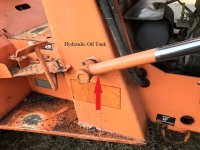SteveF
Titanium
- Joined
- Jul 4, 2004
- Location
- central NC
Need a little advice on a small repair job. The shaft welded to the side of the loader that supports the lower bucket arm has a very small, hairline crack on the bottom. This part of the machine forms the side of the hydraulic oil tank so the hairline crack is allowing oil to very slowly leak out. I’m not concerned about the leak, I’m concerned about the crack making a stress riser that will eventually cause the shaft to break off.
I “assume” that this shouldn’t be welded with oil in the crack. No problem to drain out all the hydraulic fluid. What would folks suggest for how to clean inside the crack and prep the joint?
Yes, I am having this welded by a professional shop. It’s just that many years ago I took a broken clutch arm from my Mustang to a “professional” shop to see if it could be welded. The guy said “Sure, I can do it right now”. I said “But it’s all filthy and covered in grease and dirt. Let me go home, clean it and bring it back”. He said “Nah, the heat will just burn off all that grease and dirt”. His weld lasted less than a year and I learned that just because someone does something for a living, doesn’t mean you should trust their advice.
Thanks.
Steve
I “assume” that this shouldn’t be welded with oil in the crack. No problem to drain out all the hydraulic fluid. What would folks suggest for how to clean inside the crack and prep the joint?
Yes, I am having this welded by a professional shop. It’s just that many years ago I took a broken clutch arm from my Mustang to a “professional” shop to see if it could be welded. The guy said “Sure, I can do it right now”. I said “But it’s all filthy and covered in grease and dirt. Let me go home, clean it and bring it back”. He said “Nah, the heat will just burn off all that grease and dirt”. His weld lasted less than a year and I learned that just because someone does something for a living, doesn’t mean you should trust their advice.
Thanks.
Steve





